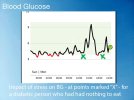bogwort47
Member
- Messages
- 17
- Location
- Hampshire, UK
- Type of diabetes
- Prediabetes
- Treatment type
- Diet only
- Dislikes
- Uncertainty, prevarication.
Hi @lovinglife
I have now had a response from my Physio to say NO steroid content in massage oil used. So, notionally I am left with your feedback which suggests that you have had similar rises from massage alone perhaps for the moment.
I take your point that you consider the change involved as small (1.5+ on Prick BG) however, my tutor on the NHS sponsored course for pre-diabetics has signalled otherwise, citing such changes as unexpected 'peaks' from my data records. Clearly views differ as to the need to investigate what is going on.
The emphasis on the course is to avoid these peaks. To avoid a peak one has to understand a the mechanism that causes it. Thus, I am inclined to the view that the better we can come to understand what is going on in our bodies (much to discover yet) the better we will be at managing matters in the future with less reliance on drugs. Equally, with a science background if "nobody knows why" crops up, it is like a red rag to a bull to find out if possible or at least add to the data bank in the hope that another may spot what is going on.
I suspect that the multiplicity of variables (not necessarily all identified yet) involved points to some potential use of AI in the future to statistically, analyse the data from a cohort by normalising transit times and the like, progressively focussing on the change agents; no agent identified as a statistically likely cause, would point to something else to be discovered. Sometimes we can characterise the something without knowing what it is exactly and go looking for it, as happened with the neutrino during my life time.
Very closely linked to bowel transit times, which vary from person to person and from food to food there is an overall hysteresis effect (delayed action) which 'writings' seem light on, but for example you mention can result in days of continuing raised BG from some foods in your experience.
Thank you again for sharing. b
I have now had a response from my Physio to say NO steroid content in massage oil used. So, notionally I am left with your feedback which suggests that you have had similar rises from massage alone perhaps for the moment.
I take your point that you consider the change involved as small (1.5+ on Prick BG) however, my tutor on the NHS sponsored course for pre-diabetics has signalled otherwise, citing such changes as unexpected 'peaks' from my data records. Clearly views differ as to the need to investigate what is going on.
The emphasis on the course is to avoid these peaks. To avoid a peak one has to understand a the mechanism that causes it. Thus, I am inclined to the view that the better we can come to understand what is going on in our bodies (much to discover yet) the better we will be at managing matters in the future with less reliance on drugs. Equally, with a science background if "nobody knows why" crops up, it is like a red rag to a bull to find out if possible or at least add to the data bank in the hope that another may spot what is going on.
I suspect that the multiplicity of variables (not necessarily all identified yet) involved points to some potential use of AI in the future to statistically, analyse the data from a cohort by normalising transit times and the like, progressively focussing on the change agents; no agent identified as a statistically likely cause, would point to something else to be discovered. Sometimes we can characterise the something without knowing what it is exactly and go looking for it, as happened with the neutrino during my life time.
Very closely linked to bowel transit times, which vary from person to person and from food to food there is an overall hysteresis effect (delayed action) which 'writings' seem light on, but for example you mention can result in days of continuing raised BG from some foods in your experience.
Thank you again for sharing. b

